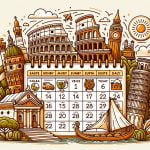Italy has long been renowned as one of the world’s top travel destinations, captivating visitors with its rich history, fascinating culture, and iconic landmarks. From the ancient ruins of Rome to the enchanting canals of Venice, Italy offers a breathtaking tapestry of experiences for travelers. Beyond its historical treasures, Italy’s diverse landscapes and world-renowned cuisine further add to its allure.
With a deep-rooted history dating back thousands of years, Italy is a treasure trove for history buffs. The country boasts numerous UNESCO World Heritage sites, including the Colosseum in Rome, the ancient city of Pompeii, and the historic center of Florence. Visitors also have the opportunity to explore Renaissance art masterpieces in museums like the Uffizi Gallery and marvel at architectural wonders such as St. Mark’s Basilica in Venice.
But Italy’s appeal extends far beyond its historical significance. Each region in Italy offers its own unique cultural traditions and culinary delights. From savoring Neapolitan pizza in Naples to indulging in gelato on the streets of Florence, food lovers can immerse themselves in Italy’s world-famous gastronomy. Moreover, travelers can discover an array of landscapes ranging from the rolling vineyards of Tuscany to the dramatic cliffs and clear waters along the Amalfi Coast.
Whether it’s delving into ancient ruins or indulging in authentic Italian cuisine, traveling to Italy promises an unforgettable experience that caters to all interests. With so much to offer, it’s crucial to consider when is the best time to visit this remarkable country based on individual preferences and desires.
Italy’s Climate and Weather
One important factor to consider when planning a trip to Italy is understanding the country’s climate and weather patterns. Italy’s geographic location results in diverse climate zones, ranging from a Mediterranean climate in the coastal regions to a continental climate in the northern part of the country. Each season brings its own unique charm and experiences, making it crucial to choose the best time to visit based on preferred temperature and weather conditions.
Springtime Splendor
April is an excellent month to travel to Italy for those seeking mild temperatures, blooming landscapes, and lesser crowds. As spring arrives, Italy emerges into a riot of colors with vibrant flowers covering meadows and hillsides. The warmer weather provides the perfect opportunity to explore outdoor attractions such as stunning gardens, romantic villas, and charming countryside towns.
One highly anticipated event during April is Easter, which brings lively celebrations across the country. Witnessing religious processions, beautiful church services, and enjoying traditional Italian Easter meals are highlights of this festive time.
Sizzling Summers
If a sun-soaked beach vacation is what you’re after, then July and August are ideal months to visit Italy’s Mediterranean coastline. During these months, Italy experiences its hottest weather with temperatures reaching their peak. This period attracts tourists from all over the world who come to enjoy the warm waters of the Adriatic and Tyrrhenian seas.
Popular coastal destinations like the Amalfi Coast and Italian Riviera come alive with an exciting summer atmosphere as beach clubs buzz with activity. It’s essential to plan ahead for accommodations in these sought-after locations due to high demand.
Autumn Charm
For those who prefer milder temperatures and picturesque scenery, September and October are great months to visit Italy. Autumn brings cooler weather while maintaining pleasant days that are perfect for exploring historical sites or taking scenic hikes. The countryside transforms into a colorful tapestry of orange, red, and gold as nature prepares for the winter ahead.
Notably, Italy’s autumn is also harvest season, offering a chance to indulge in the country’s renowned culinary delights. Food festivals celebrating truffles, wine tastings in vineyards, and other gastronomic events make this time of year extra special.
Understanding Italy’s climate and weather patterns is essential when deciding on the best month to travel to this fascinating country. Whether you’re looking for blooming landscapes in springtime, a sun-drenched summer vacation by the coast, scenic autumn beauty, or a wintertime wonderland experience, Italy has something to offer during every season. Consider your preferences for temperature and activities, and plan your Italian adventure accordingly for an unforgettable journey.
Springtime Charm
April is a wonderful month to travel to Italy, as the country starts to come alive with vibrant colors and pleasant weather. In this section, we will explore the charm of visiting Italy in April, highlighting the blooming landscapes, mild temperatures, and lesser crowds that make it an ideal time to explore this beautiful country. Additionally, we will discuss the Easter celebrations and festivals that take place during this month, adding even more excitement and cultural experiences for travelers.
Blooming Landscapes and Mild Temperatures
One of the main reasons why April is a great month to visit Italy is because of its breathtaking landscapes. As spring arrives, the countryside transforms into a sea of colorful flowers and blossoming trees. Travelers can expect to see rolling hills dotted with flowering meadows, vineyards coming alive with new growth, and gardens filled with tulips, daffodils, and cherry blossoms. This burst of natural beauty creates a picturesque backdrop for any Italian adventure.
In addition to the stunning scenery, April also offers mild temperatures throughout most of Italy. The days are generally sunny and warm without being too hot or humid, making it comfortable for outdoor activities like sightseeing or enjoying al fresco dining at sidewalk cafes. The cooler evenings may require a light jacket or sweater, especially in northern regions or higher elevations such as Tuscany or Umbria.
Easter Celebrations and Festivals
Another highlight of traveling to Italy in April is experiencing the Easter celebrations and festivals that are deeply rooted in Italian culture. From vibrant processions to religious ceremonies at historic churches and cathedrals, there are numerous opportunities for travelers to witness these traditional customs firsthand.
One particularly notable celebration is held in Rome at St. Peter’s Square on Easter Sunday when thousands gather to witness the Pope deliver his message from the balcony above. The impressive Holy Week processions leading up to Easter Sunday are also held in cities like Florence, Venice, and Palermo, offering an authentic cultural experience for visitors.
Furthermore, April is the time for many festivals across Italy. The Festa di San Marco in Venice, the Festival of Sant’Agata in Catania, and the Scoppio del Carro (Explosion of the Cart) in Florence are just a few examples of the lively celebrations that take place during this month. These festivals are complete with parades, music, dancing, and delicious local food specialties – providing visitors with an unforgettable taste of Italian traditions.
Visiting Italy in April allows travelers to immerse themselves in both nature’s beauty and cultural festivities. The combination of blooming landscapes and milder weather creates an ideal setting for exploration, while the Easter celebrations and festivals offer unique glimpses into Italy’s rich cultural heritage. Whether it’s soaking up the stunning scenery or participating in traditional customs, April truly captures the springtime charm of Italy.
Summer Bliss
Italy’s Mediterranean coastline is a dream destination for many travelers, and the months of July and August offer the perfect opportunity to enjoy its summer bliss. With its sunny beach weather and vibrant atmosphere, these months are ideal for those seeking a coastal getaway filled with sun, sea, and relaxation.
During July and August, Italy’s Mediterranean coastline comes alive with beachgoers, locals, and tourists alike. The warm temperatures make it perfect for soaking up the sun on the sandy beaches or taking refreshing swims in the clear blue waters of the Mediterranean Sea.
Whether you prefer popular destinations like the Amalfi Coast with its picturesque towns perched on cliffsides or the glamorous Italian Riviera with its charming seaside resorts, you’ll find no shortage of idyllic spots to enjoy Italy’s spectacular coastline.
One of the highlights of visiting Italy’s Mediterranean coastline during July and August is experiencing the vibrant summer atmosphere that fills the air. Coastal towns and cities come alive with festivities, including music festivals, outdoor concerts, and lively nightlife. From beach parties to coastal promenades lined with cafes and bars, there is always something exciting happening along Italy’s Mediterranean coast.
To make the most of your summer bliss in Italy, it’s recommended to plan ahead and book accommodations in advance. With so many tourists flocking to popular coastal areas during July and August, availability may be limited. Additionally, be prepared for crowded beaches during this time as many locals take their annual vacations during these months as well.
Autumn Colors and Culinary Delights
September and October are an enchanting time to visit Italy, as the country transforms into a picturesque autumn wonderland. The weather during these months is mild, making it perfect for exploring the charming streets and landmarks of Italy’s cities and towns. One of the main highlights of visiting Italy in September and October is experiencing the culinary delights that come with the harvest season.
During this time, Italy’s countryside becomes a vibrant canvas of red, orange, and yellow hues as leaves change color. The landscapes are incredibly picturesque, providing a stunning backdrop for outdoor activities such as hiking and cycling. Popular regions to visit during autumn include Tuscany, Umbria, and Piedmont. These areas offer breathtaking views of rolling hills dotted with vineyards and olive groves.
In addition to beautiful scenery, autumn in Italy is also synonymous with delicious food. It is during this time that many food festivals take place across the country. September sees grape harvesting and wine festivals where visitors can taste some of Italy’s finest wines. Truffle festivals are also held in certain regions like Alba, where visitors can sample this delicacy at its peak freshness.
To fully experience the culinary delights of autumn in Italy, consider taking part in wine tastings or joining cooking classes where you can learn traditional Italian recipes using seasonal ingredients. Exploring local farmer’s markets is another great way to immerse yourself in the flavors of fall while connecting with locals who provide fresh produce.
Traveling to Italy in September or October not only offers beautiful landscapes but also provides an opportunity to indulge in authentic Italian cuisine at its best. Whether you choose to explore historic cities or venture into lesser-known regions, your autumn trip to Italy will surely be one filled with colors, flavors, and unforgettable experiences.
The Magic of Winter
December is a magical time to visit Italy and experience the festive season in all its splendor. The country comes alive with enchanting Christmas markets, dazzling decorations, and a joyful atmosphere. Cities like Rome and Florence showcase the holiday spirit at its finest, making December an excellent month for travelers seeking a unique and unforgettable Italian experience.
One of the highlights of visiting Italy in December is the opportunity to immerse yourself in the enchanting Christmas markets. These markets are scattered throughout various cities and towns, offering a delightful array of handicrafts, local products, and delicious food. Strolling through these markets allows you to soak up the festive atmosphere while finding unique gifts for loved ones back home.
In addition to the Christmas markets, cities like Rome and Florence adorn their streets with stunning seasonal decorations. Piazza Navona in Rome is transformed into a winter wonderland with its famous Christmas market and magnificent lights. Meanwhile, Florence’s historic center sparkles with elaborate displays that capture the beauty of the season. These festive decorations add an extra touch of magic to your Italian holiday.
For those who enjoy outdoor activities, December also presents a fantastic opportunity to hit the slopes in Italy’s beautiful Dolomites. With breathtaking landscapes and world-class ski resorts, this mountain range offers endless fun for both beginners and experienced skiers alike. After spending your days on the slopes, you can cozy up next to a fireplace in one of the charming mountain lodges or indulge in traditional alpine cuisine.
Whether you’re captivated by Christmas markets, enchanted by city decorations, or seeking snowy adventures in the mountains, Italy in December has something for everyone. Immerse yourself in the festive cheer of this enchanting country during one of its most magical seasons and create memories that will last a lifetime.
Hidden Gems
Italy is a popular tourist destination with a rich history, fascinating culture, iconic landmarks, diverse landscapes, and world-renowned cuisine. While Italy attracts tourists year-round, it experiences peak seasons in the spring and summer months. However, for those looking to avoid large crowds and enjoy a more intimate experience of the country, the off-peak months of May and September offer some hidden gems.
One advantage of visiting Italy during these off-peak months is that there are generally fewer tourists. This means shorter lines at popular attractions, more availability at hotels and restaurants, and a more relaxed atmosphere overall. Additionally, prices tend to be more affordable compared to peak season rates. Travelers can often find deals on accommodations and activities during these months.
Another advantage of traveling to Italy in May and September is the opportunity to explore lesser-known cities and regions without the crowds. While cities like Rome, Florence, Venice, and Milan are must-visit destinations, Italy has so much more to offer beyond its famous cities.
Exploring smaller towns and rural areas allows visitors to experience the local culture in a more authentic way. Researching regional events and festivals taking place during these months can also provide unique opportunities for immersive cultural experiences.
To choose the best month for an Italian adventure that suits individual desires and preferences, it is important to consider personal interests as well as budget constraints and available vacation time. Some travelers may prioritize warm beach weather and vibrant summer festivities, making July or August their ideal choice. Others may prefer mild temperatures for outdoor activities or focus on exploring Italy’s culinary delights during the harvest season in September or October.
In summary, while Italy is a top travel destination year-round, May and September present a fantastic opportunity for those seeking hidden gems away from large crowds. With fewer tourists, more affordable prices, and the chance to explore lesser-known cities and regions of Italy, these off-peak months offer a unique Italian adventure with unforgettable memories waiting to be made.
| Advantages | Off-Peak Months |
|---|---|
| Fewer tourists | May, September |
| Affordable prices | May, September |
| Opportunity to explore lesser-known cities and regions | May, September |
Considering Personal Preferences
Italy is a country that offers something for everyone, from historical landmarks to breathtaking landscapes and delicious cuisine. When planning a trip to Italy, it’s important to consider personal preferences in order to choose the best month to visit. There are several factors that should be taken into account when making this decision.
One factor to consider is regional events and festivals. Italy is known for its vibrant celebrations and cultural events throughout the year. Each region has its own unique traditions and festivities, so it’s worth researching what events will be taking place during your desired travel period. For example, if you’re interested in experiencing Carnivale in Venice or the Palio horse race in Siena, you’ll want to plan your trip accordingly.
Budget constraints are another important consideration. The cost of travel can vary depending on the time of year, with peak tourist seasons typically being more expensive. By traveling during off-peak months, such as May or September, you may be able to find cheaper flights and accommodations. Additionally, attractions and popular sights may have shorter lines or discounted prices during these times.
Lastly, available vacation time should also play a role in choosing the best month to visit Italy. Some individuals may have more flexibility in their schedules while others may need to work around specific dates. It’s important to make sure that the chosen month aligns with any necessary time off from work or other commitments.
By considering these factors – regional events and festivals, budget constraints, and available vacation time – travelers can make an informed decision on the best month for their Italian adventure. Whether it’s springtime charm, summer bliss on the coastline, autumn colors and culinary delights, or the magic of winter festivities – there is a perfect time for everyone to experience Italy at its finest.
| Factors | Considerations |
|---|---|
| Regional Events and Festivals | Research what events will be taking place in desired travel period |
| Budget Constraints | Consider cost of travel during peak tourist seasons versus off-peak months |
| Available Vacation Time | Ensure chosen month aligns with necessary time off from work or other commitments |
Conclusion
In conclusion, choosing the best month to travel to Italy ultimately depends on an individual’s desires and preferences. Each month offers unique advantages and opportunities for exploration and enjoyment.
For those who appreciate blooming landscapes, mild temperatures, and fewer crowds, April is a great month to visit Italy. Springtime in Italy showcases the country’s natural beauty at its finest, with colorful flowers and fresh greenery adorning the landscapes. Additionally, Easter celebrations and festivals add a touch of cultural vibrancy during this time.
If basking in the sun on Italy’s Mediterranean Coastline is your idea of bliss, then July and August are the months for you. The beach weather is perfect for swimming and sunbathing, and the vibrant summer atmosphere permeates coastal towns like the Amalfi Coast and Italian Riviera.
Autumn in Italy offers picturesque scenery with its vibrant colors and mild temperatures. September and October are particularly appealing for food lovers as it is harvest season. Truffle festivals and wine tastings take place throughout the country, showcasing Italy’s rich culinary heritage.
For those seeking a festive experience, December brings magic to Italy as cities like Rome and Florence come alive with enchanting Christmas markets and decorations. It is also an ideal time to hit the skiing slopes in the beautiful Dolomites.
However, if avoiding crowds or finding budget-friendly options is a priority, off-peak months such as May or September may be preferable. These months offer fewer tourists and cheaper prices, allowing visitors to explore lesser-known cities and regions at their own pace.
Ultimately, when choosing the best month to travel to Italy, it is essential to consider personal interests, events taking place in specific regions, budget constraints, and available vacation time. With its rich history, fascinating culture, diverse landscapes, world-renowned cuisine, there truly isn’t a bad time to visit Italy. So embark on your Italian adventure with confidence that no matter when you go; you are sure to make unforgettable memories.

I’m a passionate traveler, writer, and Italophile. My fascination with Italy’s history, art, and culture has led me on countless adventures across the Italian landscape. Through “I Live Italy,” I share my love for this extraordinary country and aims to inspire others to explore its boundless beauty.





